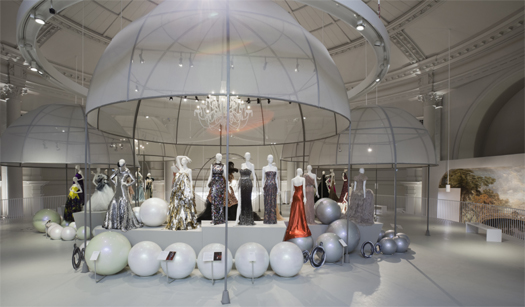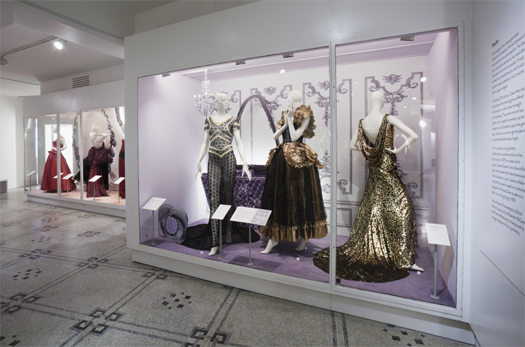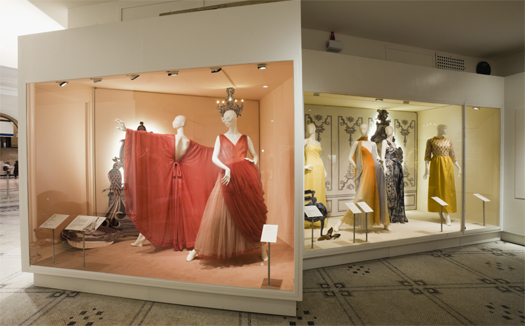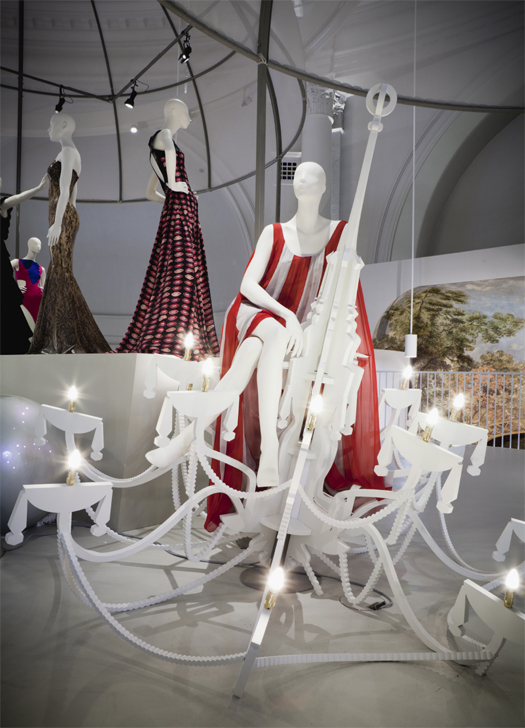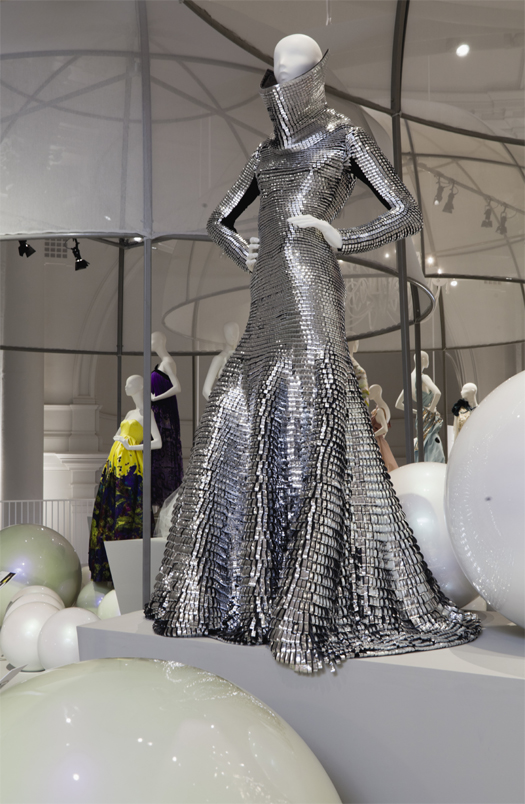Ballgowns: British Glamour Since 1950
/Victoria & Albert Museum, London, 19 May 2012-6 January 2013
by Jeffrey Horsley
'Ballgowns: British Glamour since 1950' is the first temporary exhibition to be held in the Victoria & Albert Museum’s newly restored Octagon Court, a spacious gallery with a high, domed ceiling, long the home of the Museum’s Fashion Galleries. Curated by Oriole Cullen, Curator of Modern Textiles & Fashion, and Sonnet Stanfill, Curator of Twentieth Century & Contemporary Fashion, the exhibition comprises over 60 outfits by British-based fashion designers from the 1950s to the present day, combining items drawn from the Museum’s holdings alongside loans from designers. The exhibition is staged in two sections; ‘Ballgowns Since 1950’ on the ground floor, ‘Contemporary Ballgowns’ on the mezzanine level. The press release proposes that the sections evoke respectively ‘the excitement of preparing for a ball in a grand country house’ and ‘the glamour of the red carpet or a couture presentation.’
‘Ballgowns Since 1950’ is staged in a low-ceilinged space defined by large, fixed vitrines. Exhibits are organised chromatically, with cases themed to gowns in black and red, black and emerald, acid yellows, fawn and pinks, blues and ivories. This is a particularly effective strategy, exerting a visual harmony across garments from different periods designed for different occasions. Case interiors are painted a sympathetic pastel tone with either a matching carpet or black and white tile-effect flooring. Several vitrines have backgrounds of photographic reproductions of gilded panelling from the Music Room of Norfolk House, London. Many cases present two-dimensional, cut-out images of furniture and fittings evocative of eighteenth century English town house décor, with rear-mounted LEDs casting a glowing aura around each image.
On the mezzanine level, a floor-plan unencumbered by fixed display cases and circumscribed by an open railing creates a gallery that appears to float beneath the expansive dome of the Octagon Court. Here, ‘Contemporary Ballgowns’ is arranged on three runway-like podia, each set under skeletal metal-framed cupolas clad with white net that echo the architecture of the gallery and hint at the bell-like skirt of the traditional ballgown. Inside each construction hangs an illuminated stylised chandelier, composed of flat, fret-cut panels. The podia are surrounded by strings of giant pearls with slowly revolving mannequins poised on several of the pearls.
Retail-type mannequins, finished in a pale-grey colour, without indication of make-up or hair-style, are used throughout. The mannered poses of the mannequins, often incongruous in exhibitions of more humble attire, appear fitting in the presentation of these extravagant outfits - their affected gestures conveying a sense of artifice that reflects the theatricality of the situations for which the gowns are intended. Notably, a striding mannequin, head held high and arms spread wide spectacularly displays a kaftan-like dress by Yuki, in raspberry-pink silk chiffon from 1972. Two further tableaux (reminiscent of the fashion photography of Tim Walker, who shot the image for the exhibition poster) are particularly effective; a mannequin in strips of red and grey silk chiffon, by Amanda Wakeley straddles a chandelier which has seemingly crashed to the floor; a figure wearing a pink and dark fawn silk satin gown by Hardy Amies languishes over a sofa which is represented as a photographic cut-out, with a pair of similarly rendered greyhounds adding to the chic elegance of the scene.
The schizophrenic qualities of the two exhibition spaces are a challenge to establishing a distinctive, unified atmosphere for the exhibition. The exhibition designer, Emily Pugh (trained as a window dresser at London’s Selfridges department store), manages to exert an aesthetic continuity through the application of a minimal colour scheme and repetition of the photographic cut-out device. Whilst achieving an impression of elegance the staging does not completely achieve the dynamic energy promised by the occasions it sets out to evoke. The ubiquitous pale grey and the two-dimensionality of the photographic props, coupled with the mannequins’ unflinching gaze cast over the visitor’s head, determines an overall effect of cool hauteur. The theatrical energy and social dynamics inherent in the locations of privileged interior and star-studded première the exhibition purports to replicate are sadly lacking.
Notably absent from the mise-en-scène are those supporting players whose attendance underlies narratives of class and gender. There is no male escort for instance, the tuxedo-wearing presence that represents both aesthetic foil (the ‘inconspicuous dark suit provides the ideal matt background before which “she” can really spring into life, with the brilliance of silk, the sparkle of jewels, the shimmer of naked skin’, as Barbara Vinken describes) and counter-part in culturally-specified gender roles. Additionally, there is no maid-servant, dresser or personal assistant, whose uniformly black-clad presence again provides aesthetic contrast and indicates narratives of class and wealth. Instead, the scenography realised for Ballgowns offers a cast of leading characters who shimmer, in alluring isolation, against ornamental backdrops.
The scenographic concept and the curatorial narrative of Ballgowns propose complex socio-cultural settings without investigating those issues of class, gender, consumption and display inherent in the suggested scenarios. The gendered dynamics of events that, according to exhibition text panels ‘oblige the wearer to present herself at her finest’ and ‘leave little room for misjudgements of taste’, pass without critical comment. On the ground floor, the clothed mannequins are positioned alongside images of antique furniture and over-scaled precious jewels, apparently as comparable trophies reflecting wealth and connoisseurship. This scenographic juxtaposition appears to articulate the couture-clad woman as decorative ornament, to be displayed, collected and owned. As Vinken notes, ‘Thorstein Veblen characterized the woman of the nineteenth century…as mobilia, as the mobile property of her husband.’ Ballgowns side-steps the opportunity to engage with those potentially controversial but compelling and complex narratives that are embedded in the scenarios it presents. The exhibition strives to invoke, without criticism, a rarefied world where beauty is the great leveller. As the Italian couturier Valentino confides: ‘like I love a beautiful lady, like I love a beautiful dog, like I love a beautiful piece of furniture. I love beauty…it is not my fault.’
Even the symbiosis of glamour and celebrity that is central to the exhibition’s theme, yet which cultural theorist and author Elizabeth Wilson articulately proposes as ‘polar opposites’, is left unexplored by the curators - although not by the designers themselves. A striking gown by Gareth Pugh, for instance, provokes the viewer to reconsider the popular vision of red carpet glamour. Constructed from loops of silver coated leather that descend from a raised, eye-level collar to a floor skimming hem, Pugh’s ensemble stretches the conventional ideal of the ballgown to breaking point. Its shimmering, carapace-like appearance returns to the essence of Wilson’s notion of glamour as a scintillating, mystical, illusory force. This gown stands in emphatic contradiction to the notion of body (and soul) baring glamour that Wilson berates and that ‘red-carpet’ dresses often display. Pugh’s construction is exemplary, and representative of the tour de force design and execution that is the heart of Ballgowns.
As Gareth Pugh’s contribution illustrates, what is remarkable in this selection is how designers draw on the tradition of the ‘statement’ dress and transform it into a vehicle for technical experimentation. This is particularly evident on the upper floor, where gowns by McQueen, Galliano and Westwood are presented alongside inventive work from relative newcomers; Craig Lawrence’s nest-like concoction of knitted gold and silver foil; Nicholas Oakwell’s digitally-printed silk zibeline gown depicting swirling galaxies; Atsuko Kudo’s lace-printed floor length latex sheath. While the avoidance of engaging critically with contextual narratives might be levelled as a short-coming of the exhibition, the strength of Ballgowns lies in the undeniable quality and sheer invention of the designs on display. Ultimately, Ballgowns is a celebration of British design and craftsmanship and it offers a captivating and expertly edited cross-section of the best of innovative, extravagant British fashion.
www.vam.ac.uk/ballgowns
Text / Jeffrey Horsley © Images / Ballgowns: British Glamour Since 1950 V&A Images © Sponsored by Coutts
1Barbara Vinken, ‘Transvesty – Travesty: Fashion and Gender’, in Fashion Theory, Volume 3, Issue 1 (New York: Berg, 1999) 37. 2 Vinken, 37. 3 Matt Tyrnauer, Valentino: The Last Emperor (Toronto: Phase 4 Films, 2009). 4 Elizabeth Wilson, ‘A Note on Glamour’, in Fashion Theory, Volume 11, Issue 1 (New York: Berg, 2007) 95-108.

